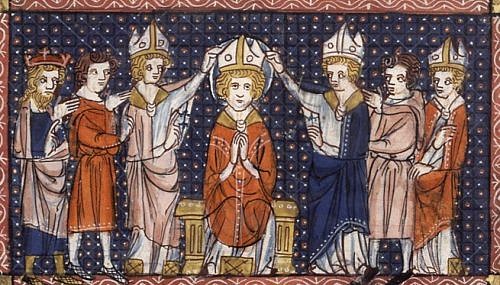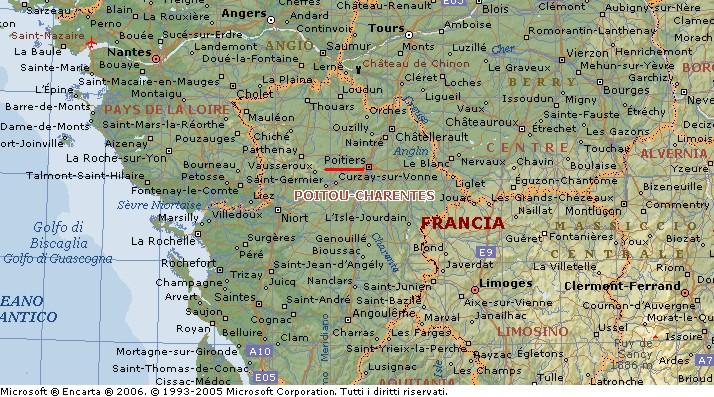Lessico
Sant'Ilario di Poitiers

Santo,
vescovo, scrittore latino cristiano (Poitiers ca. 315-367). Dalla filosofia
pagana si volse allo studio delle Sacre Scritture e abbracciò il
cristianesimo con tanto fervore che poco dopo fu acclamato vescovo dal clero e
dal popolo. Fu intrepido nella lotta all'arianesimo![]() , subendo
per essa l'esilio a opera di Costanzo II (356). Nella sua opera maggiore, De
Trinitate, conciliando fede e ragione condusse con rigoroso ordine logico
l'indagine sui misteri più alti della fede, combattendo l'eresia ariana.
, subendo
per essa l'esilio a opera di Costanzo II (356). Nella sua opera maggiore, De
Trinitate, conciliando fede e ragione condusse con rigoroso ordine logico
l'indagine sui misteri più alti della fede, combattendo l'eresia ariana.
L'importanza dell'opera di Ilario fu enorme sia per la teologia occidentale, in cui immise anche la cultura greca da lui conosciuta in Oriente, sia per la letteratura latina cristiana, per avervi introdotta la propria formazione retorica pagana e averne ampliato il lessico con una nuova terminologia. Altri scritti: In Matthaeum commentarius, Tractatus super Psalmos, Tractatus in Iob.

Sant'Ilario di Poitiers
Sant'Ilario di Poitiers (Poitiers, 315 circa–367) è stato un filosofo e scrittore francese. È venerato come santo dalla Chiesa anglicana e dalla Chiesa cattolica. Fu vescovo di Pictavium (attuale Poitiers) ed è dottore della Chiesa dal 1821. È patrono della città di Parma.
Proveniente da una famiglia aristocratica gallo-romana, Ilario fu subito attratto dalla filosofia. Era padre di famiglia quando i religiosi della sua comunità lo acclamarono vescovo di Poitiers nel 353. Ancora poco addentro ai problemi della fede, scoprì solo nel 354 il simbolo di Nicea. Fu presente al sinodo di Béziers nel 356, come al concilio di Seleucia in Isauria nel 359, dove ottenne l'unità tra i sostenitori del simbolo di Nicea e chi sosteneva che il Cristo era simile nella sostanza al Padre. A causa della sua forte opposizione all'idea ariana, per cui fu soprannominato l'Atanasio dell'Occidente, nel 356 venne mandato in esilio in Frigia dall'imperatore Costanzo II.
Nei cinque anni seguenti ebbe modo di approfondire il pensiero dei Padri orientali, maturando dentro di sé i frutti che gli permisero di scrivere la sua opera più famosa Sulla Trinità (De Trinitate). Fu nominato Dottore della Chiesa dal papa Pio IX nel 1851. La Chiesa cattolica e quella anglicana lo ricordano il 13 gennaio, suo dies natalis, ma fu iscritto nel Martirologio Romano il 14 gennaio. Di Sant'Ilario restano degli scritti esegetici e teologici e alcuni inni.
De Trinitate dove
difende la consustanzialità del "Figlio" con il "Padre",
in opposizione all'idea ariana. Quest'opera, basata su fonti greche, resta
originale nel mondo latino.
Inni, ritrovati nel 1887, di argomento dottrinale.
Contra Arianos vel Auxentium Mediolanensem liber
Contra Constantium Augustum liber
Commentarius in Evangelium Matthaei
Tractatus super Psalmos (opera molto influenzata da Origene).
Le sue opere vennero
pubblicate da Erasmo da Rotterdam![]() a Basilea nel 1523, 1526 e
1528.
a Basilea nel 1523, 1526 e
1528.
Hilarius or Saint Hilary (ca. 315– 368) was bishop of Poitiers (Pictavium) and considered an eminent doctor of the Western Christian Church. He was sometimes referred to as the malleus Arianorum (hammer against Arianism) and the "Athanasius of the West". His name comes from the Greek word for happy or cheerful, the root also of the English word "hilarious". He died on January 13, which accordingly is his feast day in the Roman Catholic calendar of saints. In the past, when this date was occupied by the Octave Day of the Epiphany, his feast day was moved to 14 January, where it appears in the General Roman Calendar as in 1954.
Early life
He was born at Poitiers about the beginning of the 4st century AD. His parents were pagans of distinction. He received a good education, including what had even then become somewhat rare in the West, some knowledge of Greek. He studied, later on, the Old and New Testament writings, with the result that he abandoned his Neo-Platonism for Christianity, and with his wife and his daughter (traditionally named as Saint Abra) received the sacrament of baptism.
So great was the respect in which he was held by the citizens of Poitiers that about 353, although still a married man, he was unanimously elected bishop (clerical celibacy was not required by the church until the late Middle Ages). At that time Arianism was threatening to overrun the Western Church; to repel the disruption was the great task which Hilary undertook. One of his first steps was to secure the excommunication, by those of the Gallican hierarchy who still remained orthodox, of Saturninus, the Arian bishop of Arles and of Ursacius and Valens, two of his prominent supporters.
About the same time, he wrote to Emperor Constantius II a remonstrance against the persecutions by which the Arians had sought to crush their opponents (Ad Constantium Augustum liber primus, of which the most probable date is 355). His efforts were not at first successful, for at the synod of Biterrae (Béziers), summoned in 356 by Constantius with the professed purpose of settling the longstanding disputes, Hilary was, by an imperial rescript, banished with Rhodanus of Toulouse to Phrygia, where he spent nearly four years in exile.
Theological work
Thence, however, he continued to govern his diocese; while he found leisure for the preparation of two of the most important of his contributions to dogmatic and polemical theology: the De synodis or De fide Orientalium, an epistle addressed in 358 to the Semi-Arian bishops in Gaul, Germany and Britain, expounding the true views (sometimes veiled in ambiguous words) of the Eastern bishops on the Nicene controversy; and the De Trinitate libri XII, composed in 359 and 360, in which, for the first time, a successful attempt was made to express in Latin the theological subtleties elaborated in the original Greek. The former of these works was not entirely approved by some members of his own party, who thought he had shown too great a forbearance towards the Arians; he replied to their criticisms in the Apologetica ad reprehensores libri de synodis responsa.
In 359 Hilary attended the convocation of bishops at Seleucia Isauria, where, with the Egyptian Athanasians, he joined the Homoousian majority against the Arianizing party headed by Acacius of Caesarea; from there he went to Constantinople, and, in a petition (Ad Constantium Augustum liber secundus), personally presented to the emperor in 360, repudiated the calumnies of his enemies and sought to vindicate his trinitarian principles.
His urgent and repeated request for a public discussion with his opponents, especially with Ursacius and Valens, proved at last so inconvenient that he was sent back to his diocese, which he appears to have reached about 361, within a very short time of the accession of Julian.
Expulsion from Milan
He was occupied for two or three years in combating Arianism within his diocese; but in 364, extending his efforts once more beyond Gaul, he impeached Auxentius, bishop of Milan, and a man high in the imperial favour, as heterodox. Summoned to appear before Emperor Valentinian I at Milan and there maintain his charges, Hilary had the mortification of hearing the supposed heretic give satisfactory answers to all the questions proposed; nor did his denunciation of the metropolitan as a hypocrite save himself from an ignominious expulsion from Milan.
In 365 he published the Contra Arianos vel Auxentium Mediolanensem liber, in connection with the controversy; and also (but perhaps at a somewhat earlier date) the Contra Constantium Augustum liber, in which he pronounced that lately-deceased emperor to have been the Antichrist, a rebel against God, "a tyrant whose sole object had been to make a gift to the devil of that world for which Christ had suffered."
Hilary is sometimes regarded as the first Latin Christian hymnwriter, but none of the compositions assigned to him is indisputable. The later years of his life were spent in comparative quiet, devoted in part to the preparation of his expositions of the Psalms (Tractatus super Psalmos), for which he was largely indebted to Origen; of his Commentarius in Evangelium Matthaei, an allegorical exegesis of the first Gospel; and of his no longer extant translation of Origen's commentary on Job.
While he thus closely followed the two great Alexandrians, Origen and Athanasius, in exegesis and Christology respectively, his work shows many traces of vigorous independent thought. Towards the end of his episcopate and with his encouragement Martin, the future bishop of Tours, founded a monastery at Ligugé in his diocese. He died in 368; no more exact date is trustworthy.
Discussion
He holds the highest rank among the Latin writers of his century prior to St. Ambrose. Designated already by Augustine of Hippo as "the illustrious doctor of the churches"; he, by his works, exerted an increasing influence in later centuries; and by Pope Pius IX he was formally recognized as universae ecclesiae doctor (i.e. Doctor of the Church) at the synod of Bordeaux in 1851. Hilary's day in the Roman calendar is January 13, from which the name of Hilary term is derived.
Editions of his writings were produced by Erasmus (Basel, 1523, 1526, 1528). An English translation by E. W. Watson appears in Nicene and Post-Nicene Fathers. Several of his works have appeared in Sources Chrétiennes (i.e. commentaries on Psalm 118 and St. Matthew, his attack on the emperor Constantius, on the Mysteries and most recently, in three volumes, on the Trinity). Recent research has distinguished between Hilary's thought before his period of exile in Phrygia under Constantius and the quality of his later major works. He was, perhaps, mentioned by Augustine as being the author of Ambrosiaster. A vita of Hilary was written by Venantius Fortunatus c.550 but is not considered reliable. More trustworthy are the notices in Jerome (De vir. illus. 100), Sulpicius Severus (Chron. ii. 39-45) and in Hilary's own writings.
Cult
The cult of Saint Hilary developed in association with that of St. Martin of Tours as a result of Sulpicius Severus' Vita Sancti Martini and spread early to western Britain. The villages of St Hilary in Cornwall and Glamorgan and that of Llanilar in Cardiganshire bear his name. In France the majority of dedications to Saint Hilary are to be found to the west (and north) of the Massif Central from which areas the cult eventually extended to Canada.
In north-west Italy the church of sant’Ilario at Casale Monferrato was dedicated to him as early as 380 AD. In the context of English educational and legal institutions Saint Hilary's festival lies at the start of the Hilary Term which begins in January.